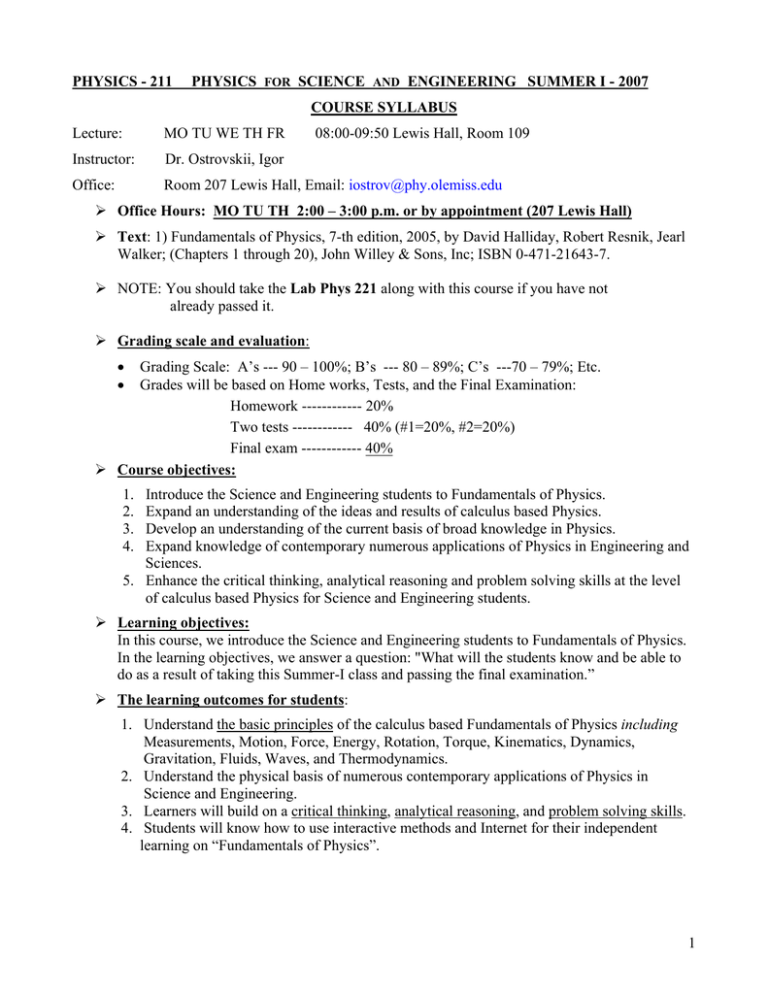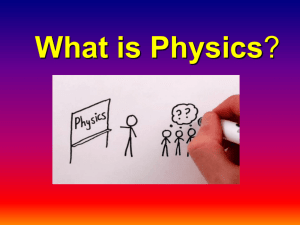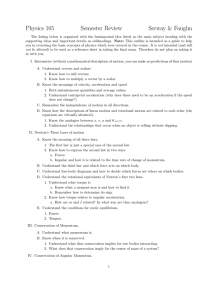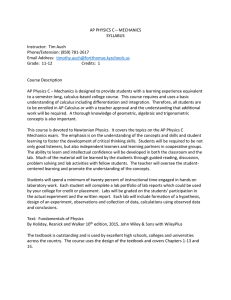PHYSICS - 211 PHYSICS SCIENCE COURSE SYLLABUS
advertisement

PHYSICS - 211 PHYSICS FOR SCIENCE AND ENGINEERING SUMMER I - 2007 COURSE SYLLABUS Lecture: MO TU WE TH FR 08:00-09:50 Lewis Hall, Room 109 Instructor: Dr. Ostrovskii, Igor Office: Room 207 Lewis Hall, Email: iostrov@phy.olemiss.edu ¾ Office Hours: MO TU TH 2:00 – 3:00 p.m. or by appointment (207 Lewis Hall) ¾ Text: 1) Fundamentals of Physics, 7-th edition, 2005, by David Halliday, Robert Resnik, Jearl Walker; (Chapters 1 through 20), John Willey & Sons, Inc; ISBN 0-471-21643-7. ¾ NOTE: You should take the Lab Phys 221 along with this course if you have not already passed it. ¾ Grading scale and evaluation: • • Grading Scale: A’s --- 90 – 100%; B’s --- 80 – 89%; C’s ---70 – 79%; Etc. Grades will be based on Home works, Tests, and the Final Examination: Homework ------------ 20% Two tests ------------ 40% (#1=20%, #2=20%) Final exam ------------ 40% ¾ Course objectives: 1. 2. 3. 4. Introduce the Science and Engineering students to Fundamentals of Physics. Expand an understanding of the ideas and results of calculus based Physics. Develop an understanding of the current basis of broad knowledge in Physics. Expand knowledge of contemporary numerous applications of Physics in Engineering and Sciences. 5. Enhance the critical thinking, analytical reasoning and problem solving skills at the level of calculus based Physics for Science and Engineering students. ¾ Learning objectives: In this course, we introduce the Science and Engineering students to Fundamentals of Physics. In the learning objectives, we answer a question: "What will the students know and be able to do as a result of taking this Summer-I class and passing the final examination.” ¾ The learning outcomes for students: 1. Understand the basic principles of the calculus based Fundamentals of Physics including Measurements, Motion, Force, Energy, Rotation, Torque, Kinematics, Dynamics, Gravitation, Fluids, Waves, and Thermodynamics. 2. Understand the physical basis of numerous contemporary applications of Physics in Science and Engineering. 3. Learners will build on a critical thinking, analytical reasoning, and problem solving skills. 4. Students will know how to use interactive methods and Internet for their independent learning on “Fundamentals of Physics”. 1 1. 2. 2. 4. 5. ¾ Homework Rules: Home works are assigned almost every class period and are due in one-two days. Homework paper should be 8.5 x 11 inches with no torn or tattered edges and should be stapled. Show all your work; the answer alone is not worth anything. Homework problems must include enough English to be understandable. Homework answers should have units and a reasonable number of significant digits. ¾ Circle the finale answers that you want to be graded. Tests and Final examination schedule: TEST 1 (Part 1), Chapters 1 through 9 -------------- Thursday, June 7 TEST 2 (Part 2), Chapters 10 through 18 -------------- Thursday, June 21 FINAL EXAMINATION ---------- 8 a.m. Monday, June 25, 2007 ¾ Common Courtesy Guidelines: • • • • • • For the benefit of your fellow students and your instructor, you are expected to practice common courtesy with regard to all course interactions. For example: Show up for class on time. Do not leave class early, and do not rustle papers in preparation to leave before class is dismissed. Be attentive in class; stay awake, do not read newspapers, etc. If you must be late or leave early on any particular day, please inform your instructor in advance. After the first day, you will need to sit in the same seat for each class. Absence may jeopardize your standing because you are responsible for any in-class activities. Students who do not practice common courtesy should not expect a good standing because their in-class activity is under the question. COURSE CONTENTS 1. MEASUREMENTS • Motion, position, displacement, velocity, acceleration. • Graphical integration in motion analysis. 2. MOTION ALONG A STRAIGHT LINE • Motion, position, displacement, velocity, acceleration. • Graphical integration in motion analysis. 3. VECTORS (Vectors, scalars, unit vector, vector algebra.) 4. MOTION IN TWO AND THREE DIMENSIONS • Position and Displacement, Velocity, Acceleration. • Projectile motion, Circular motion, Relative motion. 5. FORCE AND MOTION - I • Newtonian Mechanics; Newton’s First, Second & Third Laws. 6. FORCE AND MOTION - II • Friction, Drag force, Terminal speed. 7. KINETIC ENERGY AND WORK • Kinetic energy; Work; Work of the Gravitational force, Spring and Variable force. 8. POTENTIAL ENERGY AND CONSERVATION OF ENERGY 2 • Work and potential energy (PE) , path independence of conservative force. • Conservation of mechanical energy, Conservation of Energy. 9. CENTER OF MASS AND LINEAR MOMENTUM. • Center of mass, Newton’s 2nd Law for a system of particles, Linear momentum. • Collision and Impulse, Conservation of Linear momentum, Inelastic and Elastic collisions. TEST #1, Chapters 1 through 9 Æ Thursday, June 7 10. ROTATION. • Rotational variables, Angular variables, Kinetic energy of rotation, Torque. • Newton’s 2nd Law for rotation, Work and Rotational Kinetic energy. 11. ROLLING, TORQUE AND ANGULAR MOMENTUM. • Rolling, Kinetic energy of rolling, Angular momentum, Newton’s 2nd law. • Angular momentum of a Rigid body rotating, Conservation of Angular momentum. 12. EQUILIBRIUM AND ELASTICITY. • Equilibrium, Center of gravity, Elasticity. 13. GRAVITATION. • Newton’s law of gravitation, Gravitational field and principle of superposition. • Gravitational PE, Gravitation near and inside Earth, Kepler’s Laws. 14. FLUIDS. • Density and Pressure, Pascal’s and Archimedes principles, Bernoulli’s Equation. 15. OSCILLATIONS. • Simple harmonic motion, Energy in SHM, Pendulums. • Damped SHM, Forced oscillations and Resonance. 16. WAVES – I. • Types of waves, Wavelength and Frequency, Speed of traveling wave. • Energy and Power of traveling wave, Wave Equation, Interference, Standing waves. 17. WAVES – II. • Sound waves, Speed, Interference, Intensity, Sources, Beats, Doppler Effect. 18. TEMPERATURE, HEAT, AND FIRST LAW OF THERMODYNAMICS. • Temperature, Zeroth Law, Celsius and Fahrenheit Scales, Thermal expansion, 1st Law. ¾ TEST #2 (class 35), Chapters 10 through 18 Æ Thursday, June 21 19. THE KINETIC THEORY OF GASES. • Ideal Gases; Pressure, temperature and RMS Speed; Translational Kinetic Energy. • Mean free path; Distribution of molecular speed. 20. ENTROPY AND THE SECOND LAW OF THERMODYNAMICS. 21. REVIEW. (Last class # 38) ¾ FINAL EXAMINATION: Æ 8 a.m., Monday, June 25, 2007 * - The Chapter schedule is tentative, and may be changed (but not the Final Exam!). 3






